Physical Address
The sheer number of resident positions available in a specialty also plays a role in how competitive it is to match into. For instance, though just 173 U.S. MD seniors applied to interventional radiology residencies in 2023, they were vying for only 51 available spots, which works out to 0.18 positions available for every applicant. On the other hand, while internal medicine attracted around 4,000 allopathic M4 applicants, it also offered over 9,000 positions, meaning that there were more than two positions available for every U.S. MD senior who applied.
The Most Competitive Specialties in the NRMP Match 2022
Cardiology is key for impressive USMLE scores. Master cardiology from a Harvard-trained anesthesiologist who scored USMLE 270 with these 130+ high-yield flash cards. You’ll be begging for cardio questions – even if vitals make you queasy.
it’s free!
Want FREE Cardiology Flashcards?
Cardiology is key for impressive USMLE scores. Master cardiology from a Harvard-trained anesthesiologist who scored USMLE 270 with these 130+ high-yield flash cards. You’ll be begging for cardio questions – even if vitals make you queasy.
What are the most competitive US medical specialties? What are the least competitive specialties? In this article, we’ll dive into just how competitive each of the specialties in the NRMP match is. You’ll learn how strong you must be to get into each specialty.
Summary:
- We can estimate the “competitiveness” of each NRMP specialty by looking at unmatched % and median USMLE scores for US seniors
- We derive three broad tiers of competitiveness
- Brutally Competitive (e.g., plastic surgery, orthopedic surgery)
- Competitive (e.g., general surgery, diagnostic radiology)
- Less Competitive (e.g., family medicine, pediatrics)
Table of Contents
What is the NRMP Match?
The National Resident Matching Program (NRMP) is called “The Match.” This program determines the fate of most aspiring residents in the United States.
Not Every Specialty is in the NRMP Match
For this article, we will discuss residencies and not fellowships. In other words, we won’t discuss subspecialties of general surgery like surgical oncology or thoracic surgery. Instead, we will focus on residencies.
Note that not every residency specialty participates in the NRMP Match. One notable alternative is the SF Match, ophthalmology, and plastic surgery residencies. The other major exception that comes to mind is urology, which has its own Urology Residency Match Program (i.e., the “Urology Match”).
This article will only discuss the residencies participating in the NRMP Match.
Which Residencies in the NRMP Match Are Most Competitive in 2022?
So which residencies in the 2022 NRMP Match were the most competitive? To calculate this, let’s examine which specialties had the highest unmatched % for US seniors. The unmatched % would be the total number of people who did not match in their given specialty of those who applied. US Seniors are graduating from US allopathic (MD) schools in the year of the Match. They are also the group with the highest match rate – higher than US graduates, US osteopathic seniors, US IMGs, and non-US IMGs.
So, which NRMP specialty was the most competitive in 2022, according to the unmatched % of US Seniors?
Unmatched % US Seniors (2022) Total Positions Offered Total # ALL Applicants Total US MD Senior Applicants US Senior Matched US Senior Unmatched Anesthesiology 10.46% 1,969 2,560 1,415 1,267 148 Child Neurology 1.92% 188 182 104 102 2 Dermatology 28.40% 544 834 595 426 169 Diagnostic Radiology 16.79% 1,155 1,568 911 758 153 Emergency Medicine 1.88% 2,921 2,813 1,594 1,564 30 Family Medicine 2.13% 4,916 5,055 1,500 1,468 32 General Surgery 18.41% 1,622 2,400 1,206 984 222 Internal Medicine 1.98% 9,809 11,598 3,689 3,616 73 Internal Medicine/Pediatrics 9.64% 392 458 363 328 35 Interventional Radiology 18.63% 169 226 161 131 30 Neurological Surgery 25.74% 240 379 272 202 70 Neurology 2.31% 1,014 1,249 562 549 13 Obstetrics and Gynecology 16.12% 1,503 2,044 1,315 1,103 212 Orthopaedic Surgery 34.18% 875 1,435 1,068 703 365 Otolaryngology 30.77% 361 556 455 315 140 Pathology 2.61% 631 827 230 224 6 Pediatrics 1.61% 3,016 3,153 1,682 1,655 27 Physical Medicine and Rehabilitation 13.87% 532 725 310 267 43 Plastic Surgery 37.32% 194 340 276 173 103 Psychiatry 7.83% 2,047 2,560 1,329 1225 104 Radiation Oncology 1.92% 185 162 104 102 2 Vascular Surgery 24.21% 84 143 95 72 23 We can graph the same data.
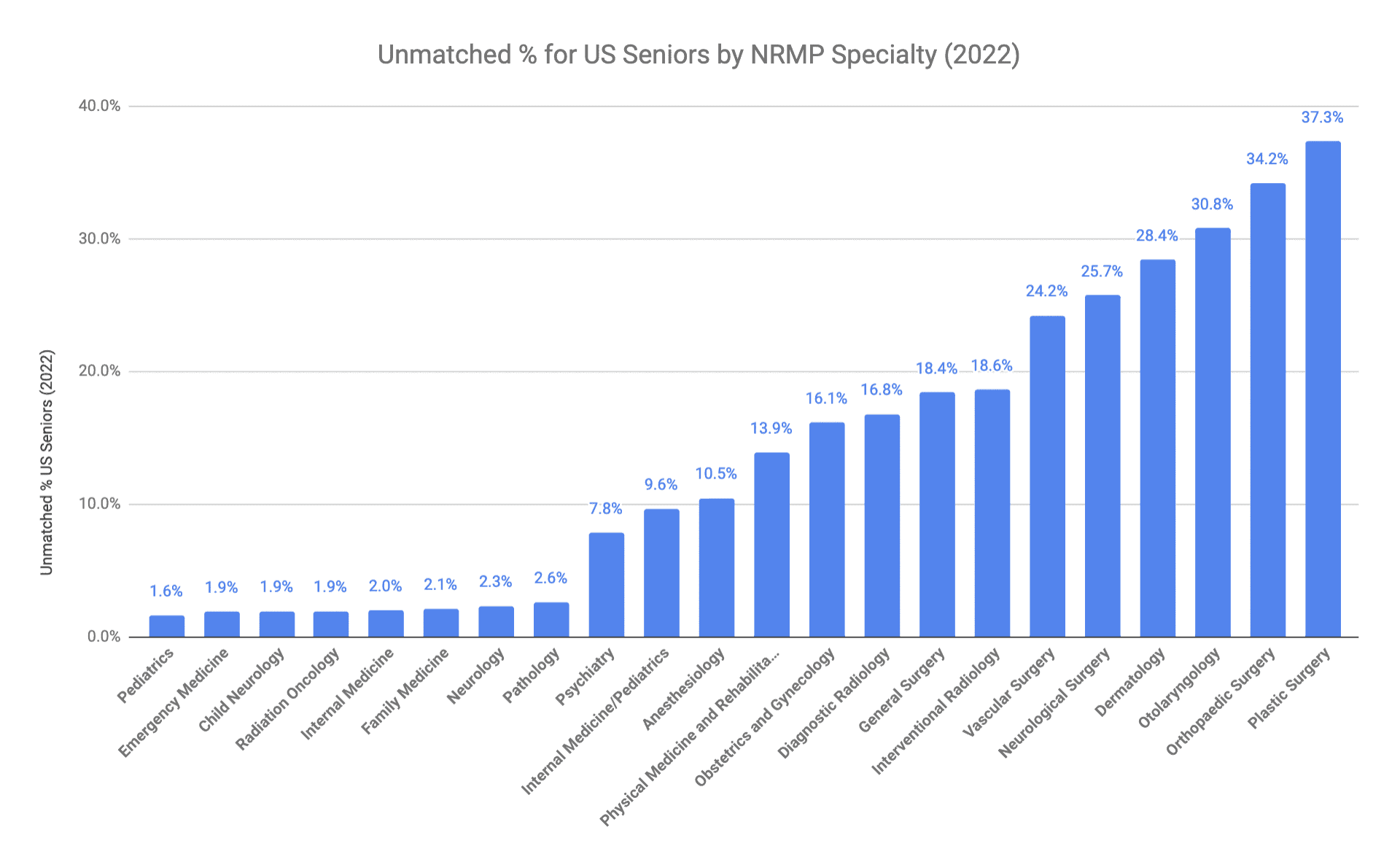
Residency Competitiveness by USMLE Step 2 CK Score
Another way to visualize the competitiveness of NRMP specialties is to look at the USMLE scores of successful applicants. Since there are few tools to make apples-to-apples comparisons across aspirants, USMLE scores are a common differentiator.

Step 1 US Seniors, 25%ile, Median, and 75%ile for Matched Applicants 2022 Match
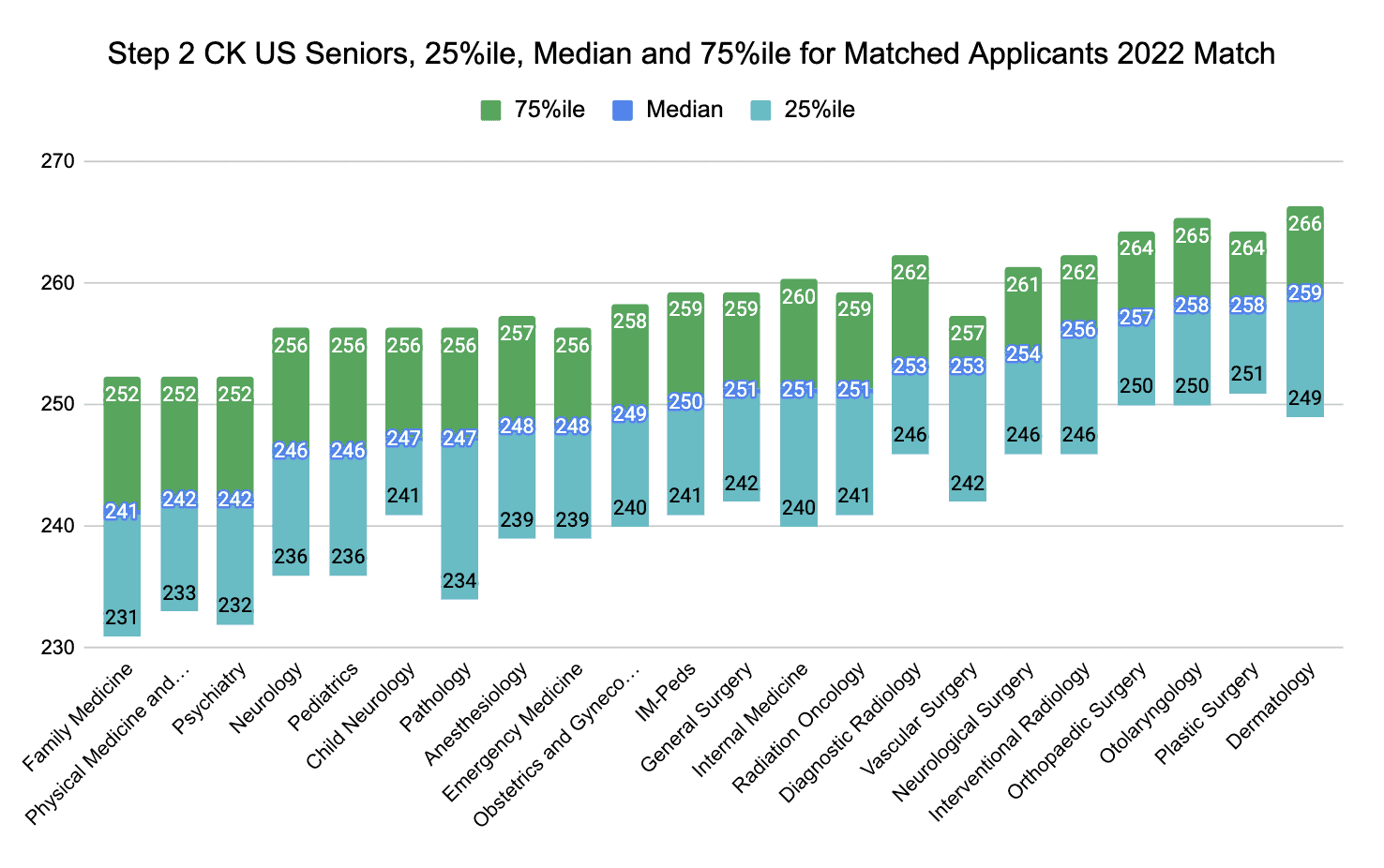
Step 2 CK US Seniors, 25%ile, Median, and 75%ile for Matched Applicants 2022 Match
As you can see, the median USMLE scores strongly correlate with the unmatched %s of each specialty. Unsurprisingly, when graphing the median Step 1 score of each specialty against the unmatched %, there is a strong correlation, with an R2 of 0.619.
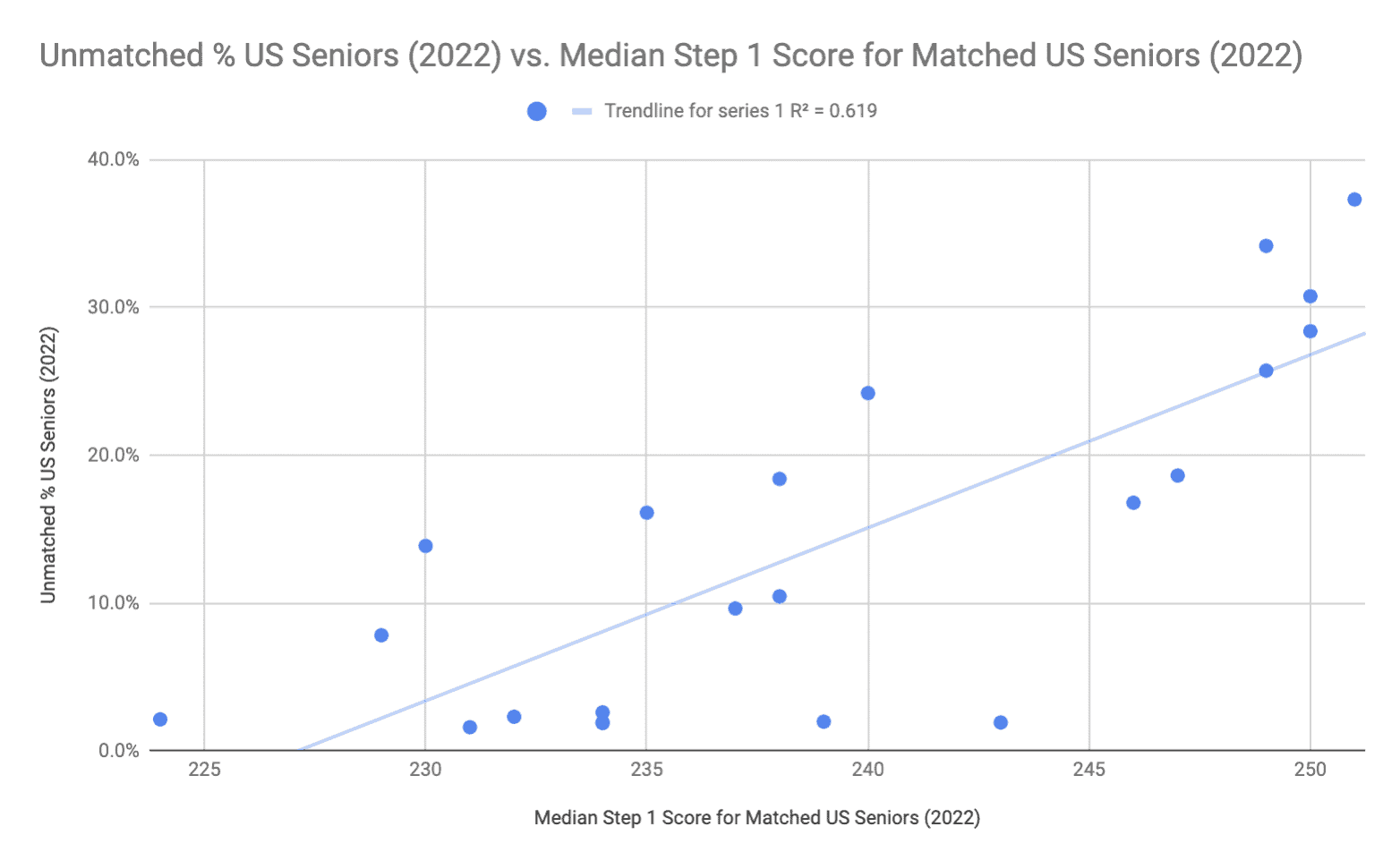
Median Step 1 of Matched US Seniors vs. Unmatched % in 2022 Match
NRMP Residency Competitiveness by Tier
From the above data, we can create three approximate tiers of competitiveness. They would be something like:
Brutally Competitive
- Plastic surgery (37.3% unmatched)
- Orthopedic surgery (34.2%)
- Otolaryngology (30.8%)
- Dermatology (28.4%)
- Neurological surgery (25.7%)
- Vascular surgery (24.2%)
Competitive
- Interventional radiology (18.6%)
- General surgery (18.4%)
- Diagnostic radiology (16.8%)
- Obstetrics and gynecology (16.1%)
- Physical medicine and rehabilitation (13.9%)
- Anesthesiology (10.5%)
- Internal medicine/pediatrics (9.6%)
- Psychiatry (7.8%)
Less Competitive
- Pathology (2.6%)
- Neurology (2.3%)
- Family medicine (2.1%)
- Internal medicine (2.0%)
- Radiation oncology (1.9%)
- Child neurology (1.9%)
- Emergency medicine (1.9%)
- Pediatrics (1.6%)
Some Notable Surprises
A few names jumped out when scanning through the unmatched % list.
Is Radiation Oncology Less Competitive than Family Medicine?
Probably not? For example, median USMLE scores are significantly higher for radiation oncology. But it’s surprising that fewer US seniors successfully matched into family medicine than radiation oncology.
Psychiatry, PM&R Ob-Gyn Continue to Rise the Ranks
A recent trend is that psychiatry, physical medicine and rehabilitation, and obstetrics & gynecology are considered more competitive. The data support this observation, although psychiatry and PM&R-matched applicants tend to have lower USMLE scores. (The obvious argument is…how well will your USMLE score predict your abilities as a psychiatrist/physiatrist?)
The Elephant in the Room: Lifestyle
The obvious question behind residency competitiveness is, of course, WHY are some specialties more competitive than others? Yes, some specialties have fewer spots than others, limiting how many people can enter. And yes, no doubt there is personal affinity towards each specialty.
However, it would be foolish to overlook lifestyle as a significant factor determining residency competitiveness. Let’s look at the approximate hourly salary of each specialty.
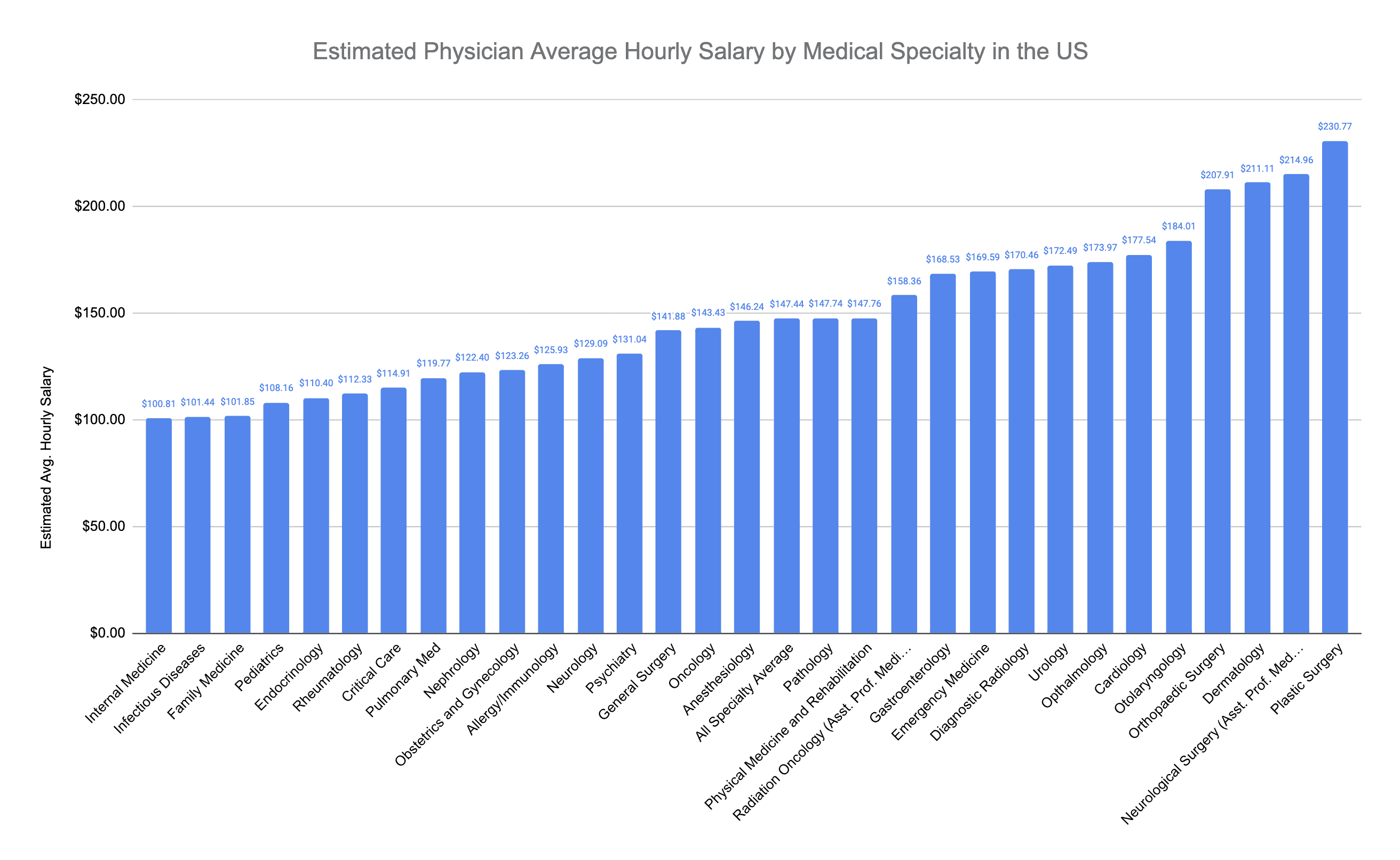
If we graph hourly salary vs. unmatched % by specialty, we see an even stronger correlation than the link between unmatched % and median Step 1 scores.
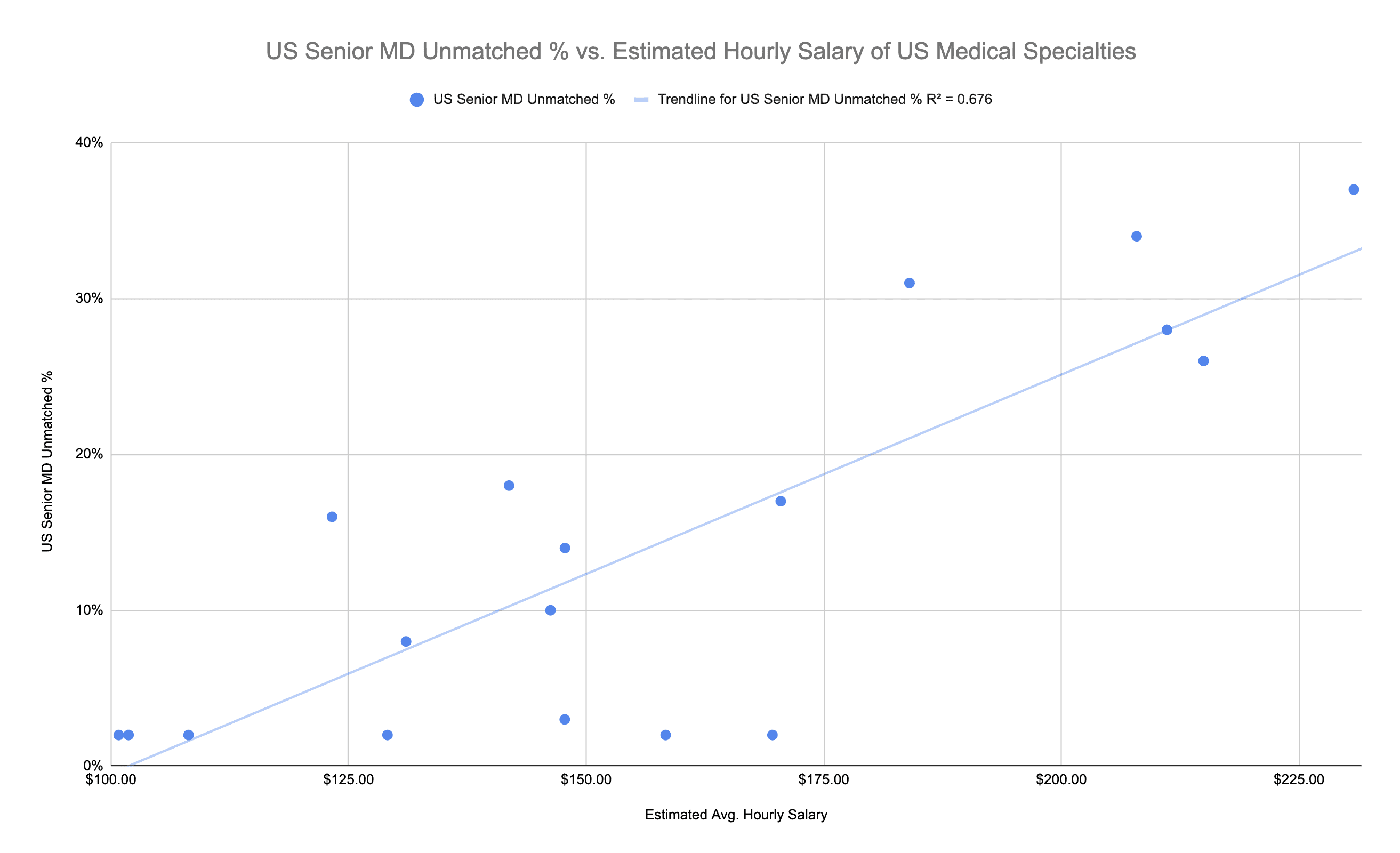
US Senior MD Unmatched % vs. Estimated Hourly Salary of US Medical Specialties
Concluding Thoughts
We’ve just presented some sobering statistics on the competitiveness of certain specialties. If you’re interested in one of those specialties, you may swing between inspiration and dread.
On the other hand, what if you’re interested in one of the “less competitive” specialties noted above? Do the lower hourly salary, and median USMLE scores mean you’re somehow “lesser”?
Of course not! Quite frankly, some of the most inspiring doctors you’ll meet are in the “less competitive” specialties. The suspicion here is that a more significant percentage of those physicians are in it for the “right reasons.”
One final thing they told us at Stanford. Just because a specialty on aggregate may be less competitive doesn’t mean that every hospital is less competitive. In particular, the most desirable residencies in each specialty would be considered, “insanely competitive.” And this was coming from the head advisor at Stanford, who no doubt is still singing a similar tune.
What do you think? Does unmatched % or median USMLE scores not accurately represent a specialty’s competitiveness? Would you use a different metric? Or chuck the whole thing? Let us know in the comments!
The Most Competitive Medical Residencies: A Complete List (2023)
A guide to the nation’s most highly selective residency specialties

Part 1: Introduction
Part 2: What are the most competitive residencies?
Part 3: Takeaways regarding the most competitive residencies
Part 1: Introduction
Though residency matching takes place during your final year of medical school, the road towards matching actually begins much earlier, with the process of choosing a medical specialty. If you’re a current medical student, you’ve probably given some thought to which specialty you’d like to go into and why.
While you’ve likely considered factors such as salary, work-life balance, and, of course, your interests, the competition to enter certain specialties sometimes gets overlooked. Nevertheless, the competitiveness of different medical residencies is an element that you should weigh while making such an important decision.
Matching with any residency position is an accomplishment, but you may find yourself facing significantly different levels of competition depending on which specialty you choose. For instance, the primary care specialties combined offer tens of thousands of residency positions annually, while in certain other fields, positions number in the single digits.
So, what are the most competitive medical residencies? In this post, we’ll address that question and others, including: What are competitive residencies’ fill rates (i.e., those that fill the highest percentage of their positions with the most allopathic M4s)? And what are the average salaries and step scores associated with these competitive specialties?
How competitive is residency matching, in general?
The 2023 NRMP Main Residency Match boasted a high number of applicants and positions, with 48,156 applicants vying for 40,375 residency spots. This statistic represents applicants graduating from both MD and DO programs, along with graduates of international medical schools (IMGs) and graduates of medical schools who didn’t match in previous years. It also accounts for postgraduate year one (PGY-1) and postgraduate year two (PGY-2) residency positions.
Among seniors at U.S. medical schools, 93.7% of MD applicants and 91.6% of DO applicants matched with a PGY-1 position. Those are somewhat reassuring statistics, but they don’t tell the whole story. Slightly over a third of those positions filled by MD seniors, and just over half of ones filled by DO seniors, were in the primary care specialties: family medicine, internal medicine, and pediatrics, which had respective fill rates of 29.2%, 36.9%, and 54.8% among U.S. allopathic medical school seniors.
When we look at the numbers for specialties outside of primary care, the competition for residency positions grows even more stiff.
For a full list of medical specialties and subspecialties, see the Association of American Medical Colleges’ comprehensive website detailing specialties and specialty paths.
Part 2: What are the most competitive residencies?
According to the American Medical Association, the NRMP considers the most competitive residency specialties to be, as we mentioned above, those with the highest fill rates—the ones that are filling their positions with the most allopathic M4s. Using this metric, along with data from the 2023 NRMP Main Residency Match on U.S. allopathic medical school seniors, we’ve compiled a list of the most competitive residency specialties among those that offered over 30 positions in 2023.
In this guide, we’ve ranked not the competitiveness of individual residency programs, but rather, the competitiveness of entire specialties. In highly competitive specialties, like the ones we’ve listed below, nearly all residency programs will be a challenge to match with.
In contrast, individual programs within less competitive specialties will have a wider range of selectivity. For instance, even though pediatrics is considered a less competitive specialty overall, some programs like Boston Children’s are still highly selective while a program like Rutgers New Jersey Medical School is considered more accessible.
Before we get into the list, here are a few points to keep in mind regarding the data you’ll encounter below:
- We’ve chosen to primarily provide data on the residency matching trends of seniors at U.S. allopathic medical schools. This isn’t to elevate this group of applicants above others, such as osteopathic med school seniors or IMGs. Rather, because U.S. MD seniors make up the largest applicant pool in the NRMP Match (around 54% in 2023), this data simply provides the clearest insight into which specialties are most competitive.
- Data on average salaries come from Doximity’s 2023 Physician Compensation Report.
- Step score statistics come from the NRMP’s 2022 Charting Outcomes in the Match report (currently the most recent available) on U.S. MD seniors and give us a picture of which specialties require the highest academic performances. However, as of January 2022, Step 1 is scored on a pass/fail basis. Step 1 scores are listed below since they are published in the Charting Outcomes report. NRMP states that the majority of applicants whose data is reflected in the report took Step 1 earlier than the January 2022 change to pass/fail.
List of the most competitive residency specialties
Plastic surgery (integrated)
- Fill rate (U.S. MD seniors): 92.3%
- Number of positions offered: 207
- Number of positions available per applicant (U.S. MD seniors): 0.8
- Matched applicants’ mean USMLE Step 1 score: 251
- Matched applicants’ mean USMLE Step 2 score: 257
- Unmatched applicants’ mean USMLE Step 1 score: 240
- Unmatched applicants’ mean USMLE Step 2 score: 247
- Average annual salary: $571,373
- Years of specialty training required prior to certification: 6
Otolaryngology
- Fill rate (U.S. MD seniors): 83.1%
- Number of positions offered: 373
- Number of positions available per applicant (U.S. MD seniors): 0.98
- Matched applicants’ mean USMLE Step 1 score: 250
- Matched applicants’ mean USMLE Step 2 score: 257
- Unmatched applicants’ mean USMLE Step 1 score: 243
- Unmatched applicants’ mean USMLE Step 2 score: 250
- Average annual salary: $488,536
- Years of specialty training required prior to certification: 5
Thoracic surgery
- Fill rate (U.S. MD seniors): 83.7%
- Number of positions offered: 1,736
- Number of positions available per applicant (U.S. MD seniors): 0.6
- Matched applicants’ mean USMLE Step 1 and Step 2 scores: While the NRMP hasn’t published this information, anecdotal evidence suggests that thoracic surgery mean step scores for successful applicants are similar to other integrated surgical residencies—approximately 240–250 for Step 1 and 250–255 for Step 2.
- Average annual salary: $706,775
- Years of specialty training required prior to certification: 6–8
Vascular surgery
- Fill rate (U.S. MD seniors): 80.6%
- Number of positions offered: 93
- Number of positions available per applicant (U.S. MD seniors): 1.01
- Matched applicants’ mean USMLE Step 1 score: 241
- Matched applicants’ mean USMLE Step 2 score: 250
- Unmatched applicants’ mean USMLE Step 1 score: 238
- Unmatched applicants’ mean USMLE Step 2 score: 245
- Average annual salary: $557,632
- Years of specialty training required prior to certification: 5–7
Neurological surgery
- Fill rate (U.S. MD seniors): 86.8%
- Number of positions offered: 243
- Number of positions available per applicant (U.S. MD seniors): 0.9
- Matched applicants’ mean USMLE Step 1 score: 241
- Matched applicants’ mean USMLE Step 2 score: 252
- Unmatched applicants’ mean USMLE Step 1 score: 238
- Unmatched applicants’ mean USMLE Step 2 score: 246
- Average annual salary: $788,313
- Years of specialty training required prior to certification: 7
Interventional radiology (integrated)
- Fill rate (U.S. MD seniors): 72.5%
- Number of positions offered: 51
- Number of positions available per applicant (U.S. MD seniors): 0.18
- Matched applicants’ mean USMLE Step 1 score: 245
- Matched applicants’ mean USMLE Step 2 score: 253
- Unmatched applicants’ mean USMLE Step 1 score: 238
- Unmatched applicants’ mean USMLE Step 2 score: 251
- Average annual salary: $503,564
- Years of specialty training required prior to certification: 6
Orthopedic surgery
- Fill rate (U.S. MD seniors): 76.8%
- Number of positions offered: 899
- Number of positions available per applicant (U.S. MD seniors) : 0.94
- Matched applicants’ mean USMLE Step 1 score: 248
- Matched applicants’ mean USMLE Step 2 score: 256
- Unmatched applicants’ mean USMLE Step 1 score: 241
- Unmatched applicants’ mean USMLE Step 2 score: 249
- Average annual salary: $624,043
- Years of specialty training required prior to certification: 5 years minimum, plus 2 years in clinical practice
Medicine – Pediatrics
- Fill rate (U.S. MD seniors): 78.3%
- Number of positions offered: 392
- Number of positions available per applicant (U.S. MD seniors): 1.09
- Matched applicants’ mean USMLE Step 1 score: 236
- Matched applicants’ mean USMLE Step 2 score: 250
- Unmatched applicants’ mean USMLE Step 1 score: 217
- Unmatched applicants’ mean USMLE Step 2 score: 234
- Average annual salary: $293,894
- Years of specialty training required prior to certification: 4
Part 3: Takeaways regarding the most competitive residencies
High fill rates mean high competition
To get a sense of how challenging it can be to match with residencies in the specialties we just mentioned, let’s take a closer look at fill rates.
The most selective specialties generally fill 80% or more of their resident positions with U.S. allopathic medical school seniors (and the higher the fill rate, the more competitive the specialty). As a comparison, across PGY-1 positions in all specialties, just 49.4% of positions were filled by U.S. MD seniors in 2023. And, as we noted earlier, fill rates among primary care specialties were similar or lower: 54.8% for pediatrics; 36.9% for internal medicine; and 29.2% for family medicine.
In contrasting these numbers, we can see that matching with residency positions in the eight specialties above is significantly more competitive than average.
Why are some medical specialties so competitive?
At least three things can go into making a residency specialty especially competitive: future pay, work-life balance, and the number of residency positions available.
It probably goes without saying that doctors are well paid, no matter what. The average physician’s salary in 2023 is $265,000 for primary care providers and $382,000 for specialists, yet some specialties pay far more than that. It’s clear that the most challenging residency specialties to match into correspond with some of the best-paid specialties in medicine. Surgical specialties, especially neurological and thoracic surgeries, command the highest pay grades.
On the other hand, while a specialty such as dermatology tends to pay less than the surgical specialties (though still well above average), it’s still highly competitive to enter due to its enviable work-life balance. The possibility of a flexible schedule, reasonable workload, relatively short residency length, and attractive compensation are among the reasons why many medical students are eager to become dermatologists.
The sheer number of resident positions available in a specialty also plays a role in how competitive it is to match into. For instance, though just 173 U.S. MD seniors applied to interventional radiology residencies in 2023, they were vying for only 51 available spots, which works out to 0.18 positions available for every applicant. On the other hand, while internal medicine attracted around 4,000 allopathic M4 applicants, it also offered over 9,000 positions, meaning that there were more than two positions available for every U.S. MD senior who applied.
In general, the most competitive residency specialties offer one or fewer positions per allopathic M4 applicant to that specialty.
Competitive residencies require high USMLE Step scores
Regardless of why you’re drawn to a competitive specialty, you’ll need exceptional test scores to be in the running for the most competitive residencies. The mean USMLE Step 1 and Step 2 scores among matched U.S. medical school seniors were 231.3 and 242.2, respectively, in 2022. In comparison, with the exception of vascular surgery, the competitive specialties listed above attracted applicants with test scores that were well above these averages—typically around 244 for Step 1 and 253 for Step 2.
In fact, the average Step scores of applicants who were unsuccessful in matching into the most competitive specialties were often higher than the average scores of matched applicants across all specialties.
Final thoughts
While matching is an achievement regardless of specialty, applicants to some residencies will face significantly higher competition than applicants to others.
To decide which residency specialties you should apply to, weigh your priorities in terms of factors such as compensation, work-life balance, and residency length—in addition to what suits your interests. Then, compare your USMLE Step scores to different specialties’ averages so you can make a well-informed decision that will give you the highest chances of matching straight out of medical school.









